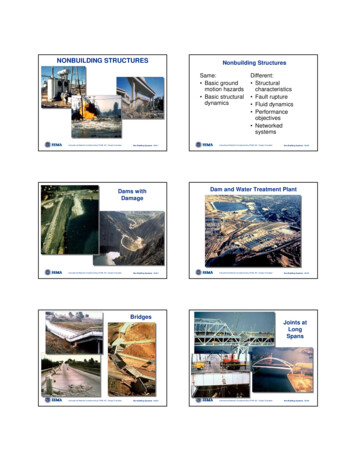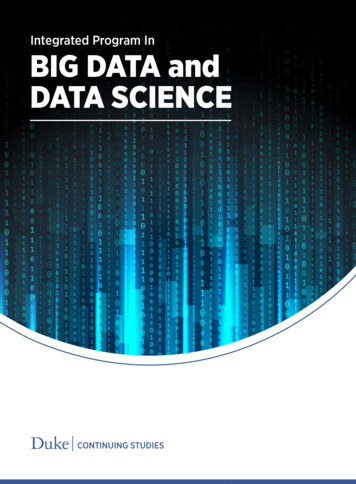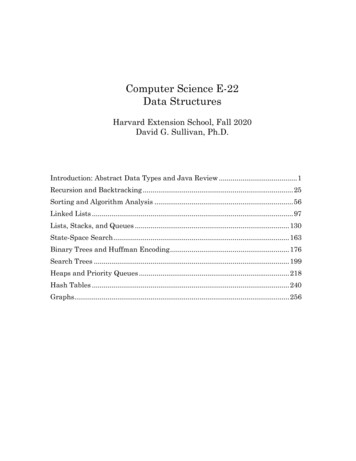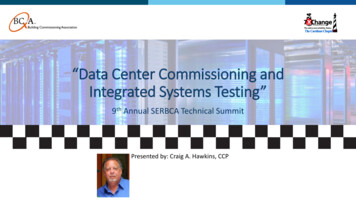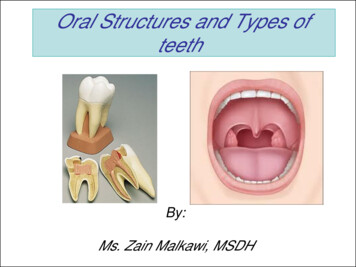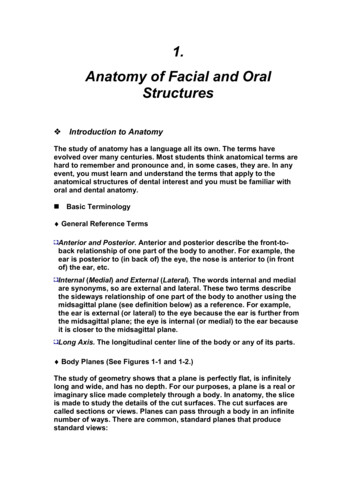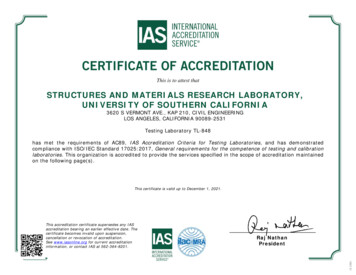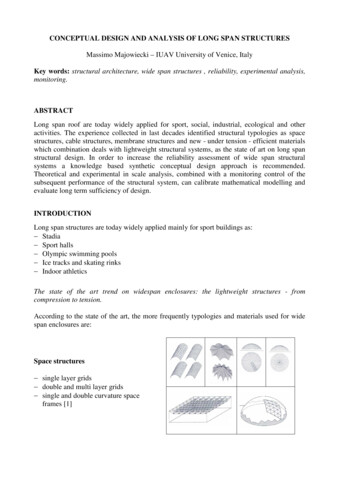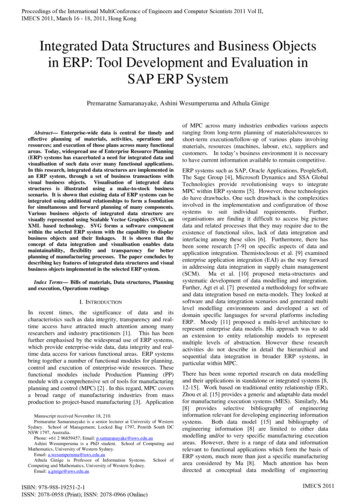
Transcription
Proceedings of the International MultiConference of Engineers and Computer Scientists 2011 Vol II,IMECS 2011, March 16 - 18, 2011, Hong KongIntegrated Data Structures and Business Objectsin ERP: Tool Development and Evaluation inSAP ERP SystemPremaratne Samaranayake, Ashini Wesumperuma and Athula Ginige Abstract— Enterprise-wide data is central for timely andeffective planning of materials, activities, operations andresources; and execution of those plans across many functionalareas. Today, widespread use of Enterprise Resource Planning(ERP) systems has exacerbated a need for integrated data andvisualisation of such data over many functional applications.In this research, integrated data structures are implemented inan ERP system, through a set of business transactions withvisual business objects. Visualisation of integrated datastructures is illustrated using a make-to-stock businessscenario. It is shown that existing data of ERP systems can beintegrated using additional relationships to form a foundationfor simultaneous and forward planning of many components.Various business objects of integrated data structure arevisually represented using Scalable Vector Graphics (SVG), anXML based technology. SVG forms a software componentwithin the selected ERP system with the capability to displaybusiness objects and their linkages. It is shown that theconcept of data integration and visualisation enables datamaintainability, flexibility and transparency for betterplanning of manufacturing processes. The paper concludes bydescribing key features of integrated data structures and visualbusiness objects implemented in the selected ERP system.Index Terms— Bills of materials, Data structures, Planningand execution, Operations routingsI. INTRODUCTIONIn recent times, the significance of data and itscharacteristics such as data integrity, transparency and realtime access have attracted much attention among manyresearchers and industry practitioners [1]. This has beenfurther emphasised by the widespread use of ERP systems,which provide enterprise-wide data, data integrity and realtime data access for various functional areas. ERP systemsbring together a number of functional modules for planning,control and execution of enterprise-wide resources. Thesefunctional modules include Production Planning (PP)module with a comprehensive set of tools for manufacturingplanning and control (MPC) [2] . In this regard, MPC coversa broad range of manufacturing industries from massproduction to project-based manufacturing [3]. ApplicationManuscript received November 18, 210.Premaratne Samaranayake is a senior lecturer at University of WesternSydney. School of Management, Locked Bag 1797, Penrith South DCNSW 1797, Australia.Phone: 61 2 96859457; Email: p.samaranayake@uws.edu.auAshini Wesumperuma is a PhD student. School of Computing andMathematics, University of Western Sydney.Email: a.wesumperuma@uws.edu.auAthula Ginige is Professor of Information Systems. School ofComputing and Mathematics, University of Western Sydney.Email: a.ginige@uws.edu.auISBN: 978-988-19251-2-1ISSN: 2078-0958 (Print); ISSN: 2078-0966 (Online)of MPC across many industries embodies various aspectsranging from long-term planning of materials/resources toshort-term execution/follow-up of various plans involvingmaterials, resources (machines, labour, etc), suppliers andcustomers. In today’s business environment it is necessaryto have current information available to remain competitive.ERP systems such as SAP, Oracle Applications, PeopleSoft,The Sage Group [4], Microsoft Dynamics and SSA GlobalTechnologies provide revolutionising ways to integrateMPC within ERP systems [5]. However, these technologiesdo have drawbacks. One such drawback is the complexitiesinvolved in the implementation and configuration of thosesystems to suit individual requirements.Further,organisations are finding it difficult to access big picturedata and related processes that they may require due to theexistence of functional silos, lack of data integration andinterfacing among these silos [6]. Furthermore, there hasbeen some research [7-9] on specific aspects of data andapplication integration. Themistocleous et al. [9] examinedenterprise application integration (EAI) as the way forwardin addressing data integration in supply chain management(SCM). Ma et al. [10] proposed meta-structures andsystematic development of data modelling and integration.Further, Agt et al. [7] presented a methodology for softwareand data integration based on meta-models. They looked atsoftware and data integration scenarios and generated multilevel modelling environments and developed a set ofdomain specific languages for several platforms includingERP. Moody [11] proposed a multi-level architecture torepresent enterprise data models. His approach was to addan extension to entity relationship models to representmultiple levels of abstraction. However these researchactivities do not describe in detail the hierarchical andsequential data integration in broader ERP systems, inparticular within MPC.There has been some reported research on data modellingand their applications in standalone or integrated systems [8,12-15]. Work based on traditional entity relationship (ER),Zhou et al. [15] provides a generic and adaptable data modelfor manufacturing execution systems (MES). Similarly, Ma[8] provides selective bibliography of engineeringinformation relevant for developing engineering informationsystems. Both data model [15] and bibliography ofengineering information [8] are limited to either datamodelling and/or to very specific manufacturing executionareas. However, there is a range of data and informationrelevant to functional applications which form the basis ofERP system, much more than just a specific manufacturingarea considered by Ma [8]. Much attention has beendirected at conceptual data modelling of engineeringIMECS 2011
Proceedings of the International MultiConference of Engineers and Computer Scientists 2011 Vol II,IMECS 2011, March 16 - 18, 2011, Hong Konginformation [13, 16]. Further, Liang and Ginige [12]proposes smart business object for web applications.However, their approach confines to only data models buthas no bearing on processes and integrated data structures asbeing used in ERP systems with cross-functionalapplications based on best business practices. Althoughthese research activities attempted to improve data in ERP,almost of all of the activities mainly focus on data modellingor systems with limited functional applications with ERPcontext.Recently, Samaranayake [17] proposed enhanced datamodels for master and transaction data in ERP systems,using unitary structuring technique [18]. The unitarystructuring technique combines hierarchical bills ofmaterials (BOM) with sequential operations routings andactivity project networks. These enhanced data modelseliminate manual interfacing and non-value added stepsinvolved in existing business transactions of functionalmodules of ERP systems. For example, production ordercycle as part of broader manufacturing planning and control,involves a number of manual steps such as capacitylevelling and component availability checking. These lead tolonger manufacturing lead-times.Samaranayake [19]examined traditional MPC approach with existing dataagainst a holistic approach with integrated data structuresand confirmed that the lead-times are significantly improvedin the latter. Even though data integration is addressed froma theoretical perspective, the lack of integrated datastructures with visual presentation in a system environmentis a prominent problem and a drawback from a usabilityperspective. For example, infinite loading of resources usingcurrent data models requires manual capacity levellingduring execution of operations. Although many ERPsystems provide a graphical framework for individual datastructures (hierarchical BOMs, sequential operationsroutings and project networks) and manual functions(graphical view for capacity levelling), they do not provide avisual representation of integrated data structures. Thissuggests that there is a need for integration of data structuresand visual presentation in an ERP system for better planningof many types of components (materials, activities,operations and resources) and execution of those plans, inparticular enhanced production planning as part of MPC.Thus, the main purpose of this research is to build aframework that visualizes the integrated data structures inMPC within an ERP system. Further, integrated datastructures when implemented in an ERP system withcapabilities of visual representation can be used to representadditional relationships between data elements. This thenwill improve planning/execution methods over manyfunctional applications and resulting in better decisionmaking. Since data is identified as one of the most covetedassets in an enterprise, integrated data structures form afundamental resource in business intelligence (BI) aimed atbetter business decision making [20]. In this research,integrated data structures are derived from exiting datamodels and this would allow intelligent information to beextracted from enterprise-wide data.Further, thisinformation would then be presented in a graphical formataiding competitive business intelligence as an additionalbenefit.The paper first outlines the research methodology,followed by an overview of existing data models andISBN: 978-988-19251-2-1ISSN: 2078-0958 (Print); ISSN: 2078-0966 (Online)limitations of current functional applications.Next,integration of data structures, using unitary structures isdiscussed. Thereafter, an overview of implementation ofintegrated data structures is presented. In this regard, SAPERP system (market leader in ERP solutions) is selected asthe platform for implementation, for its ability to supportsoftware components required for visual representation ofintegrated data structures and business objects. Graphicalrepresentation of integrated data structures is illustratedusing a selected business scenario and corresponding masterdata maintained in the SAP ERP system. Finally, the paperconcludes with the findings of this research and futuredirections.II. RESEARCH METHODOLOGYThe research methodology adopted in this study involvesexperimental testing of integrated data structures [17] in anERP system, using implementation of visual representationof integrated data structures and associated planningmethods. Experimental testing is based on a selected testcase, illustrated with practical aspects of integrated datastructures and visualisation in SAP ERP system. Thefollowing steps are planned for the implementation ofintegrated data structures and their visualisation.Step 1. Identification of current data models andlimitations in current functional applicationsRelational data tables of existing data structures (BOMs,operations routings) in SAP ERP system are identified first.Additional data tables required for the integrated datastructures are defined using attributes and relationships.Based on attributes, relationships and other technical aspectsof defined tables for integrated data structures, the integrateddata structures are mapped into a structure that can be seenas data objects within the system.Step 2. Integrated data structures using unitarystructuring techniqueIntegrated data structure, based on unitary structure isconfigured using a simple business scenario selected withinproduction planning module of SAP ERP. In this case, theselected data definitions/tables are taken into consideration,when creating a single data table for the integrated datastructure. The data table of integrated data structure is acombination of data fields, based on the knowledge(attributes, relationships and technical aspects) ofhierarchical BOMs, operations sequence, componentallocations and other relationships.Step 3. Identification of technical requirements forimplementation of integrated data structuresTechnical capabilities in particular graphical aspects of SAPERP system for developing integrated data structures andvisual business objects are analysed. This analysis includesidentification of technical constraints of SAP ERP system,in supporting implementation of integrated data structuresand their graphical visualisation.Thus, technicalrequirements within SAP ERP system are identified, fordeveloping integrated data structures and their visualisationwith required links/relationships with existing data models.IMECS 2011
Proceedings of the International MultiConference of Engineers and Computer Scientists 2011 Vol II,IMECS 2011, March 16 - 18, 2011, Hong KongStep 4. VisualstructuresrepresentationofintegrateddataThe integrated data structure, identified and maintained witha single data table outlined earlier, is displayed in agraphical format. This involves significant amount ofcoding within SAP ERP system that generates SVG datafrom the underlying integrated data structure. As part of thisprocess, the integrated data structure is expanded into onethat does not have overlapping components within the sameBOM level, using nesting procedures [21]. Application ofnesting procedures, as part of this step, would have meantthat the graphical components would not overlap each otherand make it easier to visualise. The SVG data was thenpassed into an HTML control with an embedded SVGviewer to display the graphical representation and businessobjects. Business objects represent details of each dataelement (material, operation, activity, resource) using dataattributes of each data element stored in the database of SAPERP system.Step 5. Numerical evaluation and model validationPlanning/execution methods developed earlier [2] forsimultaneous planning of materials, resources, activities andoperations of integrated data structure, with forwardplanning capabilities are implemented in SAP ERP system.This involves implementing of scheduling paths [22] andplanning algorithm [23], using a s
planning of manufacturing processes. The paper concludes by describing key features of integrated data structures and visual business objects implemented in the selected ERP system. Index Terms— Bills of materials, Data structures, Planning and execution, Operations routings I. INTRODUCTION In recent times, the significance of data and its
